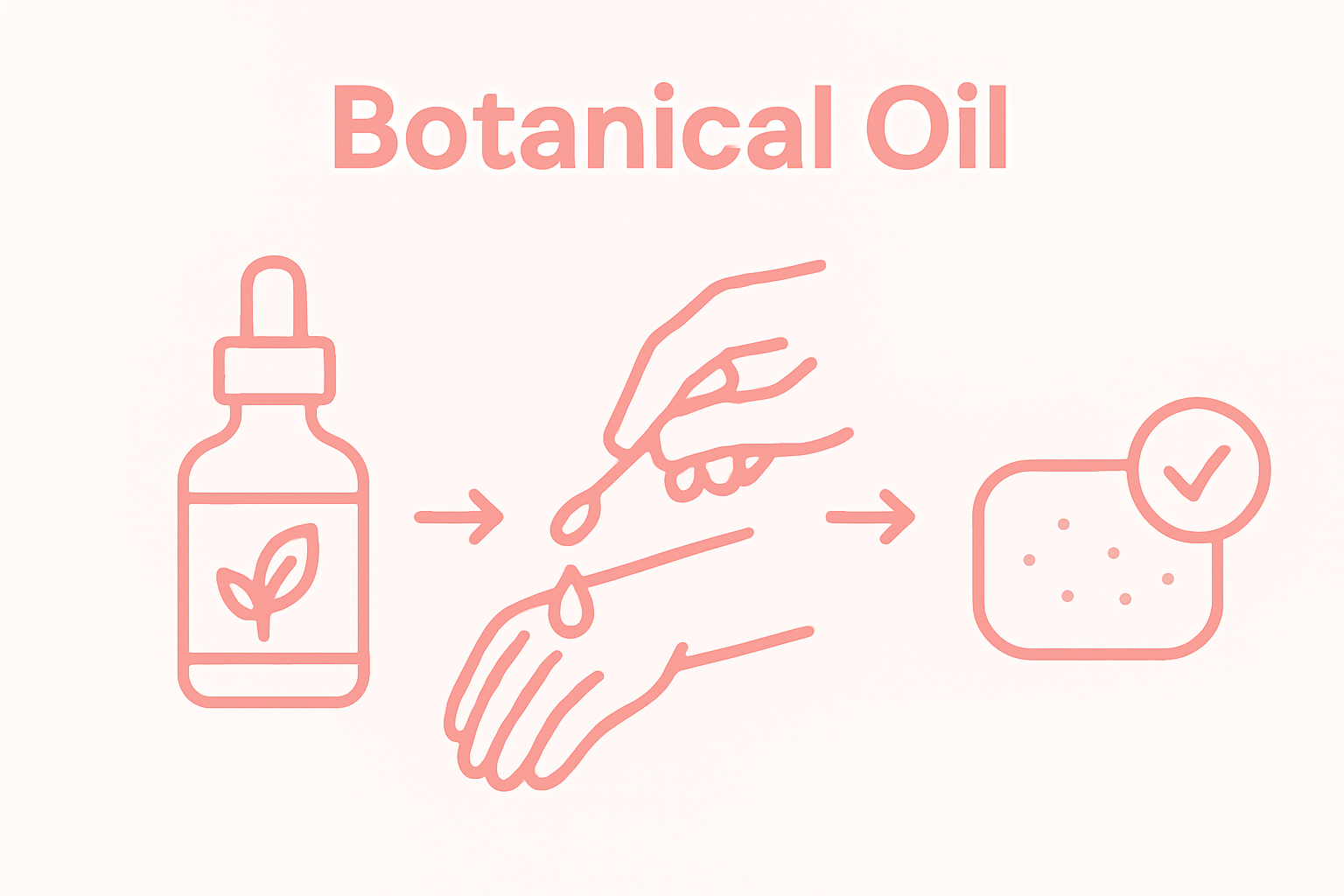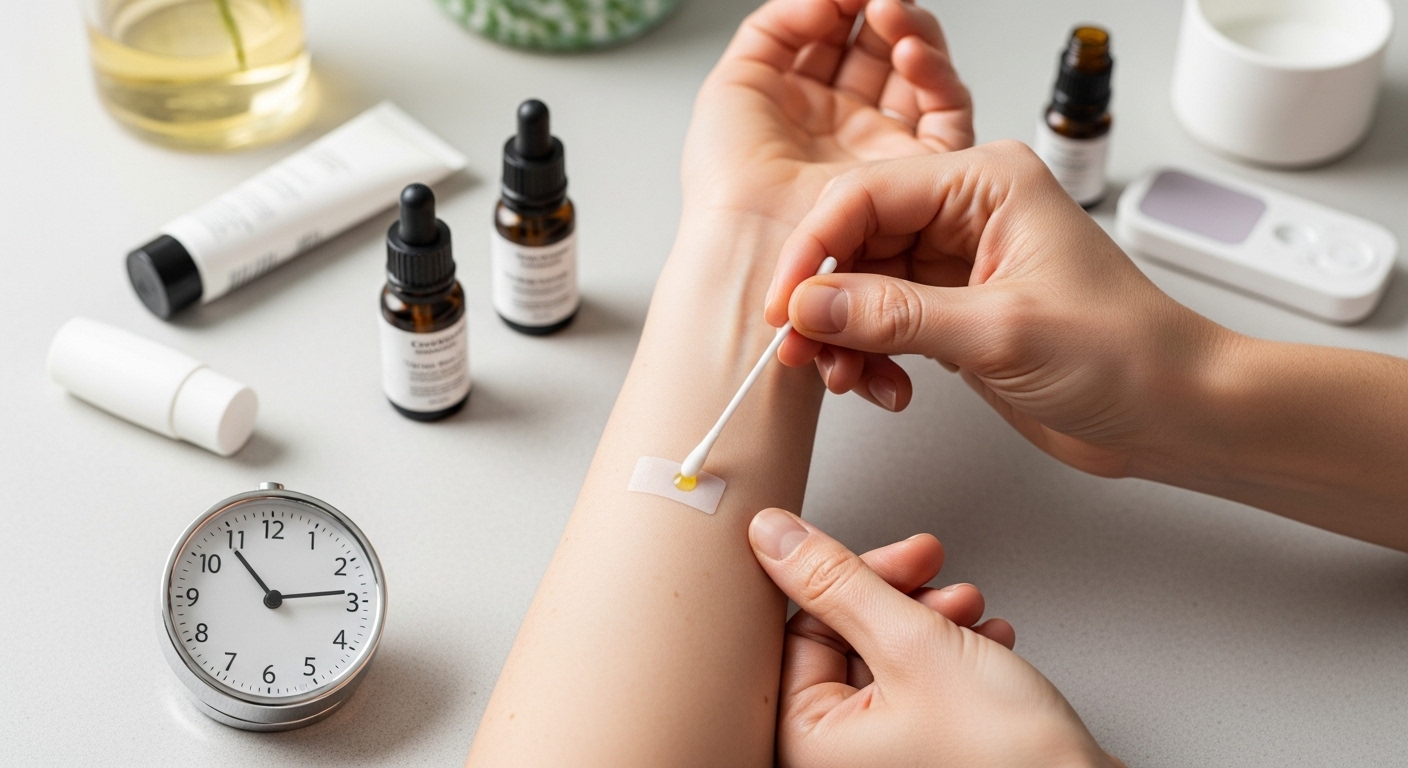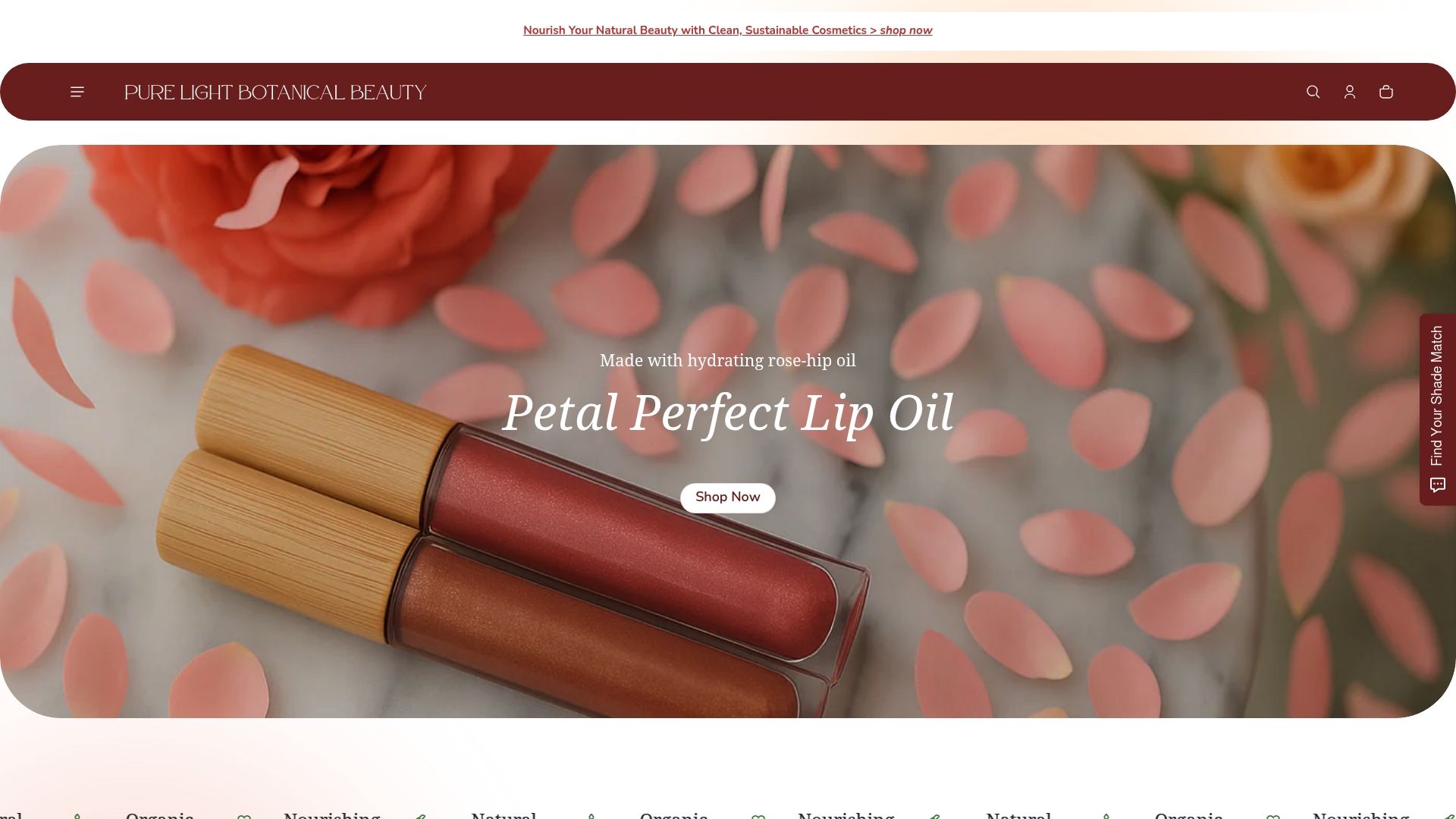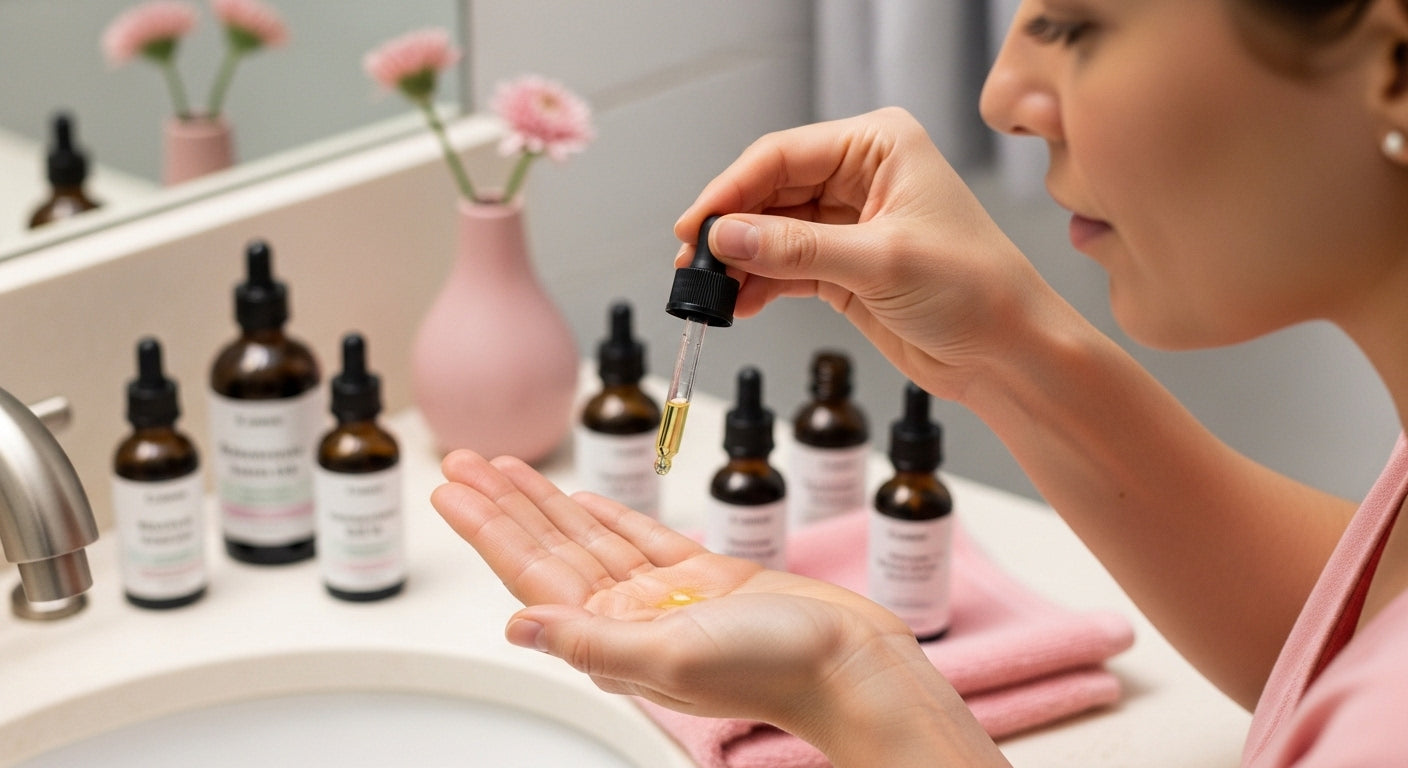Choosing botanical oils for sensitive skin can feel overwhelming. There are hundreds of options but not every oil plays nicely with delicate skin types. Here is the wild part: just a few drops of the right blend can transform your routine and spark healing—jojoba oil’s structure is so close to human sebum that your skin may accept it without a fight. The real secret is in the subtle matchmaking, not in overloading your skin with trendy products.
Table of Contents
- Step 1: Choose The Right Botanical Oils For Your Skin
- Step 2: Conduct A Patch Test For Allergies
- Step 3: Mix Oils For Optimal Skin Benefits
- Step 4: Apply Oils With A Soothing Ritual
- Step 5: Observe Skin Reactions And Adjust Usage
Quick Summary
| Key Point | Explanation |
|---|---|
| 1. Choose suitable botanical oils | Select oils with anti-inflammatory and healing properties, like jojoba, calendula, and chamomile, for sensitive skin care. |
| 2. Conduct a patch test | Perform a patch test on a small skin area to check for allergic reactions before full application of botanical oils. |
| 3. Mix oils mindfully | Blend complementary oils using a precise ratio to maximize healing effects without overwhelming your sensitive skin. |
| 4. Apply oils with intention | Use gentle, upward motion while applying oils, warming them first to enhance absorption and therapeutic effect. |
| 5. Observe skin reactions regularly | Keep a journal tracking skin responses to oils, noting improvements or reactions to tailor your skincare routine effectively. |
Step 1: Choose the Right Botanical Oils for Your Skin
Navigating the world of botanical oils for sensitive skin requires thoughtful selection and understanding. Not all plant-based oils are created equal, especially when your skin craves gentle, healing ingredients. The right botanical oil can transform your skincare routine from a potential source of irritation to a soothing, restorative experience.
Identifying Your Skin’s Specific Needs matters most when selecting botanical oils. For those with sensitive skin, look for oils with anti-inflammatory and healing properties. Jojoba oil stands out as a remarkable choice, remarkably similar to human sebum, which means it integrates seamlessly with your skin’s natural composition. Its molecular structure allows it to penetrate deeply without clogging pores or causing additional irritation. Calendula and chamomile oils offer profound calming effects, reducing redness and supporting skin’s natural healing processes.
When exploring botanical oils, consider your unique skin profile. Those with eczema or rosacea might benefit from different oils compared to someone experiencing general sensitivity. Sensitive skin requires a nuanced approach that goes beyond simple moisturization. Our guide on choosing natural makeup can provide additional insights into understanding your skin’s specific requirements.
Key factors to consider when selecting botanical oils include:
- Purity of the oil source
- Extraction method
- Potential allergen profile
- Skin absorption rate
- Molecular weight of the oil
Practically speaking, start with small patch tests. Apply a tiny amount of the chosen botanical oil to your inner forearm and observe your skin’s response over 24 hours. Look for signs of calm, hydration, and absence of irritation. Skin that feels balanced and comfortable indicates a successful match. Remember that less is more when working with sensitive skin. A few drops of the right botanical oil can provide more healing and nourishment than multiple layers of heavy, potentially irritating products.
The journey to finding your perfect botanical oil is personal and requires patience. Listen to your skin, observe its responses, and be willing to experiment gently. Your skin will communicate its preferences if you pay attention to its subtle signals.
Step 2: Conduct a Patch Test for Allergies
Before diving into a full skincare routine with botanical oils, conducting a thorough patch test is your first line of defense against potential allergic reactions. This critical step protects your sensitive skin from unexpected inflammatory responses and ensures the oils you’ve carefully selected truly support your skin’s healing journey.

Preparation is key when conducting a patch test. Gather clean cotton swabs, a small mirror, rubbing alcohol for sanitizing, and the botanical oil you want to test. Choose a quiet moment when you can remain relatively still and observe your skin’s response without disruption. The inner forearm or behind the ear are ideal testing locations because these areas have sensitive skin that closely mimics facial skin reactions.
The testing process requires methodical attention. Clean the selected skin area thoroughly with mild soap and pat dry completely. Apply a minuscule amount of the botanical oil using a clean cotton swab, creating a patch approximately the size of a dime. Do not rub the oil aggressively; instead, gently press it into the skin. Learn more about natural makeup application techniques which can complement your botanical oil testing approach.
Critical observation windows for patch testing include:
- Immediate reaction (within 15-30 minutes)
- Delayed reaction (12-24 hours)
- Extended reaction (48-72 hours)
Watch for warning signs such as redness, swelling, itching, burning sensations, or tiny bumps. These indicators suggest your skin might be rejecting the botanical oil. A successful patch test reveals no adverse reactions: your skin remains calm, comfortable, and shows no visible changes.
 If you experience any negative responses, immediately wash the area with cool water and discontinue use of that specific oil.
If you experience any negative responses, immediately wash the area with cool water and discontinue use of that specific oil.
Professional skincare experts recommend repeating the patch test twice before fully incorporating a new botanical oil into your routine. This double-verification approach provides additional confidence in your product selection. Remember that skin sensitivity can evolve, so what worked months ago might trigger a reaction today. Patience and careful observation are your greatest allies in discovering the perfect botanical oils for your unique skin profile.
Step 3: Mix Oils for Optimal Skin Benefits
Blending botanical oils is an art form that transforms individual ingredients into a powerful healing elixir for sensitive skin. The right combination can amplify healing properties, creating a synergistic effect that nurtures and protects your delicate skin barrier. Understanding oil compatibility becomes crucial in this delicate process of botanical alchemy.
Start by selecting complementary oils that address your specific skin concerns. Jojoba oil provides an excellent base due to its remarkable similarity to human sebum, making it incredibly gentle and easily absorbed. Pair this with calendula oil for its profound anti-inflammatory properties, or chamomile oil to soothe redness and calm irritated skin. Explore our nourishing lipstick guide for additional insights into skin-healing ingredients.
The mixing process requires precision and mindfulness. Use clean, dark glass dropper bottles to preserve the oils’ integrity and prevent oxidation. A general rule of thumb is to create a blend with a maximum of three different oils, allowing each ingredient to shine without overwhelming your skin. Typically, maintain a ratio of 70% base oil (like jojoba), 20% supporting oil (such as rosehip), and 10% essential oil (like lavender) for sensitive skin formulations.
Essential blending guidelines include:
- Always start with carrier oils
- Add essential oils in minimal quantities
- Shake gently to combine ingredients
- Store in cool, dark places
- Use within 3-6 months for maximum potency
Measure your oils carefully using clean droppers or pipettes. One milliliter is typically sufficient for a small batch. Gently roll the bottle between your palms to mix, avoiding vigorous shaking that might compromise the oils’ delicate molecular structures. Your finished blend should feel smooth, with no separation or cloudiness.
Verify your mixture’s effectiveness by observing your skin’s response over several applications. Healthy skin will appear calm, hydrated, and balanced. Pay attention to how your skin feels immediately after application and throughout the day. A successful botanical oil blend will provide sustained moisture without greasiness, leaving your skin with a subtle, natural radiance that speaks to deep, cellular nourishment.
Step 4: Apply Oils with a Soothing Ritual
Applying botanical oils transcends simple skincare—it becomes a meditative practice of self-nurturing and healing. Your application technique matters as much as the oils themselves, transforming a routine task into a moment of profound connection with your skin. Mindful application can significantly enhance the therapeutic benefits of your carefully selected botanical blend.
Begin by creating a calm environment. Wash your hands thoroughly and ensure your face is clean and slightly damp. Warm the oils between your palms, generating gentle heat that helps the botanical mixture absorb more effectively. This subtle warming activates the oils’ molecular structure, allowing deeper penetration and maximizing their healing potential. Learn more about natural makeup techniques that complement holistic skincare approaches.
The application technique requires gentle, deliberate movements. Use light fingertip pressure and move in upward, sweeping motions from the center of your face outward. This direction supports natural lymphatic drainage and prevents unnecessary skin pulling. Imagine you are conducting a soft, loving massage that encourages skin renewal and relaxation.
Key application principles include:
- Start with minimal oil quantity
- Distribute evenly across skin
- Use gentle, upward motions
- Avoid excessive rubbing
- Allow complete absorption
Pay special attention to areas prone to sensitivity or inflammation. For those with conditions like eczema or rosacea, extra gentleness is paramount. Let the oils rest lightly on your skin, allowing them to be absorbed naturally without aggressive manipulation. Some slight tingling or warmth is normal, but intense burning or redness signals that your skin needs a different approach.
Verify successful application by observing your skin’s immediate response. A healthy glow indicates proper absorption—your skin should look luminous, not greasy. The botanical oils should disappear quickly, leaving behind a subtle, soft radiance. Your skin should feel nourished, calm, and comfortable, with no residual heaviness or irritation. This ritual is not just about skincare; it’s a moment of self-love, a gentle reminder that healing begins with compassionate, intentional touch.
Step 5: Observe Skin Reactions and Adjust Usage
Understanding your skin’s response to botanical oils is a delicate dance of observation, patience, and intuition. Skin communication goes beyond visible symptoms, requiring a nuanced approach that honors your body’s unique signals. This step transforms your skincare routine from a static process into a dynamic, responsive dialogue with your sensitive skin.
Begin by establishing a consistent observation journal. Document not just physical skin changes, but environmental factors, stress levels, and dietary habits that might influence your skin’s reaction. Tracking these details helps you distinguish between temporary fluctuations and genuine botanical oil interactions. Small changes like slight redness, texture shifts, or moisture levels provide critical insights into how your skin metabolizes different oil combinations.
The first two weeks of botanical oil usage are particularly revealing. Our guide on natural makeup application can complement your observation techniques, offering holistic skincare perspectives. Pay attention to how your skin feels throughout the day—not just immediately after application. A successful botanical oil integration should gradually improve skin resilience, reducing sensitivity over time.
Critical observation markers include:
- Reduction in inflammation
- Improved skin hydration
- Balanced oil production
- Decreased sensitivity
- Enhanced skin texture
If negative reactions emerge, do not panic. Skin adjustment periods vary, and what appears as an adverse reaction might be a temporary purging process. Consider reducing application frequency or quantity. Some sensitive skin types require incredibly minimal oil quantities—sometimes just two to three drops spread across the entire face. Alternate between different botanical oil blends to understand which combinations your skin finds most harmonious.
Successful botanical oil integration reveals itself through subtle, cumulative improvements. Your skin should gradually appear more balanced, with reduced redness, improved elasticity, and a natural, healthy glow. The goal isn’t instant perfection but steady, gentle healing. Trust your skin’s wisdom, remain patient, and approach this journey as a compassionate exploration of your unique dermal landscape. Remember that skincare is deeply personal—what works brilliantly for one might require careful modification for another.
Here is a troubleshooting table to help you identify and address common issues when using botanical oils for sensitive skin.
| Problem | Possible Cause | Suggested Solution |
|---|---|---|
| Redness or irritation | Allergic reaction to oil | Discontinue use, wash area with cool water |
| Greasy residue | Applying too much oil | Use fewer drops, apply thin layer |
| Breakouts | Comedogenic oil or improper blend | Switch to non-comedogenic base like jojoba |
| Burning sensation | Oil is too strong or high in essentials | Dilute further or use gentler oils |
| Uneven absorption | Not warming oil before application | Warm oil between palms before applying |
| Minimal improvements | Inconsistent use or unsuitable formula | Track usage, adjust blend as needed |
Discover Gentle Relief for Sensitive Skin with Pure Light Botanical Beauty
Sensitive skin often feels unpredictable, leaving you searching for natural solutions that actually work. This article walks you through how to choose, test, and blend botanical oils as a healing ritual, helping you find calm for skin troubled by irritation, eczema, or flare-ups. But what if you could simplify this journey with products expertly crafted for sensitive skin, using the very same pure botanical oils and nourishing principles covered here?

Pure Light Botanical Beauty offers clean, plant-based formulas that support and soothe even the most delicate complexions. Each product is created with sensitive skin in mind, taking the guesswork out of ingredient selection and blending. Explore our nurturing collection, including gentle lip oils and blushes infused with healing botanicals, and reclaim comfort without compromise. Experience the next level of care today by visiting Pure Light Botanical Beauty. When your skin calls for kindness, answer with proven support from a brand that honors both your natural beauty and unique needs. Start your sensitive skin transformation now.
Frequently Asked Questions
What are the best botanical oils for sensitive skin?
For sensitive skin, oils with anti-inflammatory and healing properties are ideal. Jojoba oil, calendula oil, and chamomile oil are excellent choices as they help calm irritation and promote healing.
How do I perform a patch test for botanical oils?
To conduct a patch test, apply a small amount of the botanical oil to a clean area of skin, such as your inner forearm. Observe for any reactions over 24 to 72 hours, looking for signs like redness or itching.
How can I blend botanical oils for better results?
When mixing botanical oils, use a base oil like jojoba as 70%, add a supporting oil (20%), and a small amount of essential oil (10%). Always store the blend in dark glass bottles to maintain potency and prevent oxidation.
How often should I apply botanical oils to see improvement?
Start by applying botanical oils consistently for at least two weeks. Monitor your skin’s response, noting any adjustments in hydration, texture, and sensitivity levels to determine optimal usage frequency.
